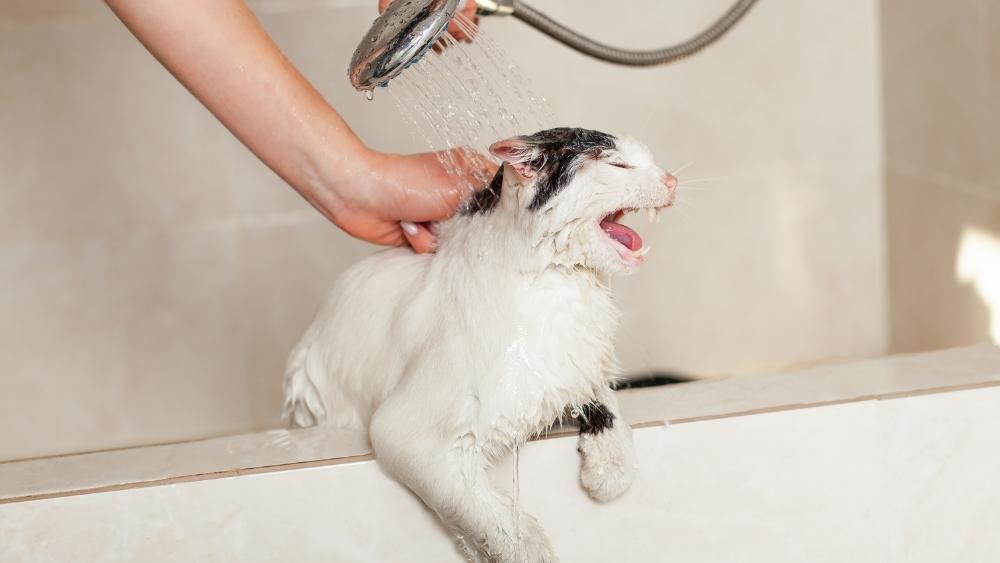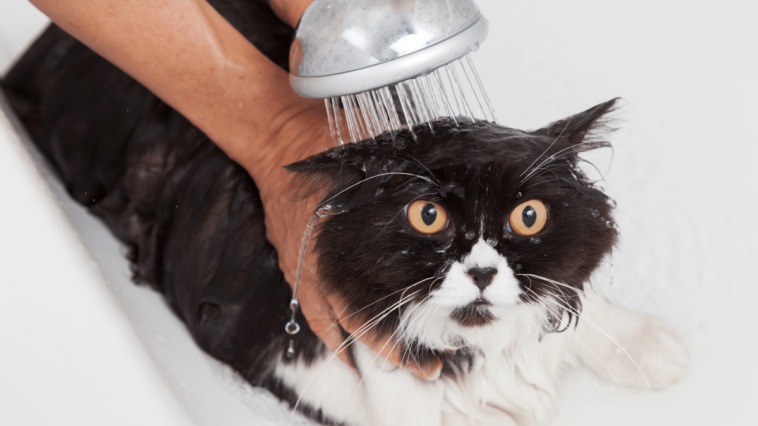Why do cats hate water? This is a question that many cat owners have asked themselves. It’s a curious feline behavior that has puzzled us for years. While dogs may enjoy a good swim, cats often have a natural aversion to water. You may have witnessed your cat frantically trying to escape a bath or hiding under the bed during a rainstorm. But why do cats hate water so much?
In this post, we’ll delve into the reasons behind this behavior, explore the theories that explain it, and offer tips on keeping your cat clean and hydrated without resorting to a full bath.
So, let’s explore the fascinating world of cats and water and discover what makes this beloved animal so opposed to one of the essential elements of life.
Why Do Cats Hate Water?
Cats are known for their grooming habits, but when it comes to water, many have an aversion to it. While some cats may be trained or conditioned to like water, many still fear or dislike it. Here are some of the reasons why cats hate water:
- Evolutionary history: Cats are descended from desert-dwelling wildcats with little need for water beyond what they obtained from their prey. As a result, they did not evolve to be proficient swimmers, and their ancestors likely needed more exposure to large bodies of water. This lack of evolutionary pressure may have contributed to cats’ aversion to water.
- Sensitive fur and skin: Cats have highly sensitive fur and skin, and they may find the water on their coat uncomfortable or distressing. Wet fur can also be heavy, making it difficult for a cat to move or escape danger.
- Sense of smell: Cats have an acute sense of smell, and the scent of chlorine or other chemicals in tap water may be off-putting. This is especially true for cats used to drinking from freshwater sources, such as rain or a stream.
- Feeling trapped: Cats are natural hunters and predators, and they may feel trapped or vulnerable in a wet environment. This can lead to panic and an intense desire to escape.
- Lack of control: Cats are known for their independent nature and desire to control their environment. Being placed in water takes away their control, which can be stressful and frightening for them.
- Negative experiences: If a cat has had a negative experience with water, such as being forced into a bath or caught in a rainstorm, it may develop a lasting aversion to it.
Cats’ aversion to water is likely a combination of evolutionary history, sensory perception, and negative experiences. While some cats may be trained or conditioned to tolerate water, it’s important to understand and respect their instincts and preferences. Additionally, alternative methods for keeping cats clean and hydrated without regular bathing exist.
Do Any Cats Like Water?
While many cats dislike water, some enjoy being in or around water. The reasons why some cats like water are not entirely clear, but it’s possible that they may have had positive experiences with water early in life or enjoy the sensation of being wet. Here are a few examples of cats that seem to enjoy the water:
- Turkish Van: The Turkish Van is a cat known for its love of water. They have a unique water-resistant coat and enjoy swimming and playing in the water.
- Bengal: Bengal cats are another breed known to enjoy the water. They have a wild ancestry that includes Asian leopard cats, known to be good swimmers.
- Maine Coon: Maine Coon cats are a large breed of cat that often enjoys playing in the water. They have a thick, water-repellent coat that helps keep them warm and dry.
- Siamese: Siamese cats are known for their outgoing personalities and curiosity; some enjoy playing in the water.
- Domestic shorthair: While not a specific breed, some domestic shorthair cats enjoy the water and may even play in a bathtub or sink.
It’s important to note that while some cats may enjoy water, most do not. It’s not recommended to force a cat to interact with water if they are uncomfortable or afraid, as this can be traumatic and potentially dangerous for the cat.
How to Bathe a Cat?

Bathing a cat can be challenging since many cats don’t like water. However, there are situations where a cat may need a bath, such as if they have gotten into something sticky or dirty or if they have skin issues that require frequent washing. Here are some steps to follow when bathing a cat:
- Choose a good location: Select a location for the bath that your cat feels comfortable in, such as a small bathroom or a laundry sink. It’s important to ensure the area is secure so your cat can’t escape.
- Get the right supplies: Gather all necessary supplies before starting the bath, including a cat-specific shampoo, a pitcher or a sprayer to rinse the cat, a non-slip mat or towel to place in the tub or sink, and a towel or two to dry the cat off after the bath.
- Brush the cat: Brush your cat before the bath to remove any loose fur or mats. This will make the bathing process more comfortable for your cat and make it easier to lather and rinse the shampoo.
- Fill the tub or sink: Fill the tub or sink with warm water to the cat’s ankles. Ensure the water is not too hot, which can be uncomfortable for the cat.
- Wet the cat: Using a pitcher or a sprayer, wet the cat’s fur, starting from the neck down. Avoid getting water in the cat’s ears, nose, or eyes.
- Apply a small amount of cat-specific shampoo and lather it into the fur, avoiding the face and ears. Be gentle when massaging the shampoo into the fur to avoid causing any discomfort or skin irritation.
- Rinse thoroughly: Using a pitcher or sprayer, rinse the shampoo thoroughly from the cat’s fur, removing all traces of soap.
- Dry the cat: Wrap the cat in a towel and pat them dry. If your cat is comfortable with the sound, you can use a hairdryer set on low and cool settings to dry the cat’s fur.
Praise and reward your cat throughout bathing to help them feel calm and comfortable. Also, consult a professional groomer or veterinarian if your cat is extremely anxious or difficult to bathe.
Can Cats Be Trained to Like Water?
Training a cat to like water is possible but challenging and requires patience and positive reinforcement. Introducing water gradually and making the experience as positive as possible is key. Here are some tips to help train a cat to like water:
- Start slow: Begin by introducing your cat to small amounts of water in a controlled environment, such as a sink or tub, and use treats and praise to reinforce positive behavior.
- Make it enjoyable: Incorporate toys or treats into the water experience to help your cat associate water with positive things. You can also add some catnip to the water to encourage your cat to investigate and play.
- Don’t force it: If your cat shows signs of discomfort or fear, don’t force them to continue with the water experience. Instead, try again later and gradually increase the time spent in the water.
- Use positive reinforcement: Reward your cat with treats and praise when they display positive behaviors around the water. This will help them associate water with positive experiences.
It’s important to remember that not all cats will ever enjoy the water, regardless of how much training or positive reinforcement they receive. If your cat shows signs of extreme fear or discomfort around water, it’s best to avoid forcing them into situations that could cause distress.
How to Keep Your Cat Clean Without Bathing
While bathing effectively keeps your cat clean, it can be optional and practical. Here are some tips to help keep your cat clean without having to bath them:
- Regular brushing: Brushing your cat regularly helps to remove loose hair, dirt, and debris from their coat, keeping them clean and preventing matting. Use a cat-specific brush or comb to prevent skin irritation.
- Wiping: Use a damp cloth or pet-safe wipe to gently clean your cat’s face, paws, and bottom. You can also use specialized cat wipes to clean their fur and skin.
- Grooming: Trimming your cat’s nails regularly will help to prevent dirt and bacteria from building up under their claws. You can also use specialized cat nail caps to keep their claws clean.
- Diet: A balanced and nutritious diet can help to promote healthy skin and coat, reducing the need for frequent bathing. Ensure your cat is receiving a high-quality, species-appropriate diet.
- Environmental cleanliness: Regularly cleaning your cat’s litter box, bedding, and any areas they frequently occupy will help to reduce odors and keep your cat clean.
By incorporating these practices into your cat’s regular care routine, you can keep them clean and healthy without having to bathe them. However, a bath may be necessary if your cat becomes dirty or smelly. In these cases, use a cat-specific shampoo and follow the proper bathing techniques to keep your cat safe and comfortable.
Water Therapy
Water therapy, or hydrotherapy, is a form of rehabilitation and pain management for cats involving controlled water exposure. It can benefit cats with various medical conditions, including arthritis, muscle and joint injuries, and post-surgery recovery.
Here are some ways that water therapy can help in the rehabilitation and pain management of cats:
- Low-Impact Exercise: Water therapy provides a low-impact form of exercise that can help cats to build strength and mobility without putting pressure on their joints. The buoyancy of water reduces the impact of gravity on the body, allowing cats to move and exercise in a safe and controlled environment.
- Increased Range of Motion: Water therapy can help to improve a cat’s range of motion by reducing stiffness and increasing flexibility. The warmth of the water can also help relax muscles and reduce pain and inflammation.
- Cardiovascular Conditioning: Water therapy can help improve a cat’s cardiovascular health by increasing its heart and respiratory rates. This can improve circulation, oxygenation, and overall physical fitness.
- Pain Relief: The warm water used in hydrotherapy can help to stimulate blood flow and increase endorphin production, which can help to reduce pain and discomfort in cats. This can be particularly beneficial for cats with chronic pain or musculoskeletal conditions.
- Improved Quality of Life: Water therapy can help improve a cat’s overall quality of life by increasing mobility and independence. It can also provide mental stimulation and reduce boredom and anxiety in cats.
Water therapy can be an effective form of cat rehabilitation and pain management. Still, it should always be done under the supervision of a veterinarian or certified animal physical therapist.
Why Do Cats Lick Each Other?
Cats are social animals with various behaviors to interact with each other, including grooming and licking. Here are some reasons why cats lick each other:
- Social Bonding: Cats that live together often lick and groom each other to strengthen their social bonds. This helps to establish a sense of familiarity and trust between cats.
- Mutual Grooming: Cats will often groom each other as a form of mutual grooming, which helps to keep each other clean and remove loose fur. This can also be a sign of affection and closeness between cats.
- Establishing Hierarchy: In multi-cat households, cats may lick and groom each other to establish their social hierarchy. This can also be a way of showing submission or dominance.
- Calming Effect: Licking and grooming can have a calming effect on cats and help to reduce stress and anxiety. This is particularly important in multi-cat households with tension or conflict.
- Healing Wounds: Cats may lick each other’s wounds to clean and promote healing. This can be a form of cooperation and support among cats.
Licking and grooming are important for cats and their social interactions and overall well-being.
Conclusion
Cats have a natural aversion to water rooted in their evolutionary history and sensory perception. While some cats may be trained or conditioned to like water, many still fear or dislike it.
Understanding the reasons behind a cat’s water aversion can help to manage their health and behavior better. There are alternative ways to keep cats clean and hydrated without regular bathing.
However, in cases where water therapy is needed for rehabilitation and pain management, controlled exposure to water can provide many benefits for cats and improve their overall well-being.




